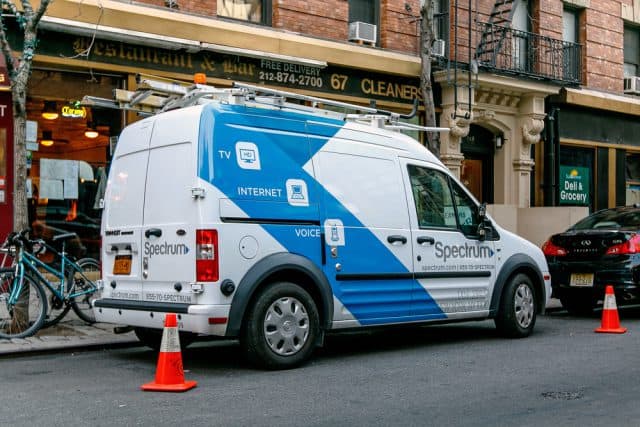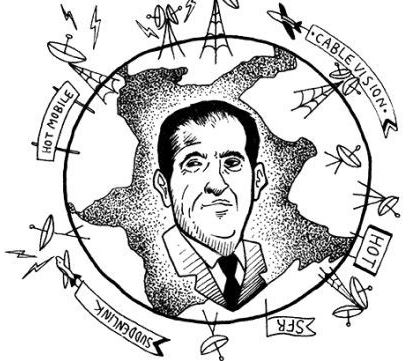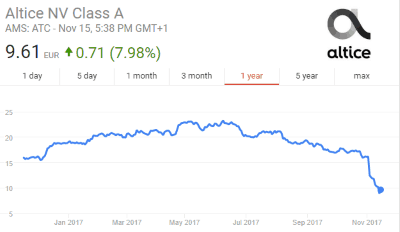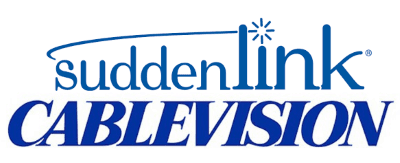Drahi also made headlines last summer by announcing SFR-Numericable was completely scrapping its coaxial cable networks in France (as well as in Cablevision territory in the United States) to move entirely to optical fiber technology, even in the most rural service areas. But the fiber upgrades are not being financed with cash on hand at Altice. Libération reports the $1.78 billion Altice will need to spend on fiber upgrades for France alone will be financed by more bank loans. Drahi hopes to eventually offer bonds to investors to internally finance fiber upgrades.
 Ralph Romano is still on hold with Charter Spectrum, waiting to report an outage that began late Sunday evening in his apartment in the Jamaica, Queens neighborhood.
Ralph Romano is still on hold with Charter Spectrum, waiting to report an outage that began late Sunday evening in his apartment in the Jamaica, Queens neighborhood.
“You sit on hold for an hour and then the call disconnects, which is exactly the kind of treatment you know you are going to get from this shabby operation,” an angry Romano tells Stop the Cap! “I am 72 years old and ran my own business for 46 years. If I treated my customers the way this cable company does, I would have been out of business in 4-6 months. I don’t know how they did it but Spectrum is even worse than Time Warner Cable.”
Romano is one of dozens of customers reportedly experiencing a multi-day outage in Queens. For some, the outage takes out phone, internet and television service but for others, internet service is the worst affected.
Romano’s neighbor gave up on wasting her cell phone minutes on hold to report the outage. She took a taxi to the Spectrum Store in Elmhurst and then waited over 90 minutes before someone called on her.

NYC rats are not to be trifled with. This one is taking a slice home on the subway.
“I just wanted to report the outage, not turn in equipment or pay a bill, but the door greeter could care less,” Sandra e-mailed us. “They want your name and then they can’t be bothered. I watched people come in after me get called up to pay their bill, sometimes with a sack of change spilled out on the table that took 15 minutes to count. It was infuriating. When they finally called me, I was helped by Mr. ‘I Don’t Care’ who wanted my account information, then said my cable box appeared to be fine. He never tested the internet modem, which is where the problem was. When I told him the whole building was out, he said he couldn’t take reports about other people and they would have to come down themselves to report the trouble. He gave me a $5 credit for service we still don’t have back. Useless.”
“We have a lot of elderly people in this building so they are not going to run down to Spectrum and wait for hours to report a problem that could be discussed over the phone,” Romano said.
Like several other buildings in Queens, there are no immediate alternatives. Although Verizon claims FiOS is available to the building where Romano lives, the only neighbor who ordered it waited two months for engineering work and then had his order summarily canceled without explanation. The building owner warned FiOS is not available because Verizon was unwilling to place its incoming cables in the appropriate conduit, which is rat-resistant.
“The rats, which can be fend off by companies like pest control green bay, around here eat anything, especially cables,” Romano said. “Everyone seems to know that except Verizon.”
Over in Kew Gardens, intermittent internet access from Spectrum is often a fact of life.

Espinal
“When it rains, the internet is gone,” says Ana López. “You might get 15 minutes worth of use, but then the cable modem light starts blinking and the service is just gone. We have called them at least 10 times, and the riff-raff they send out here couldn’t find their rear end with their hands. Since the strike, the people who knew what they were doing must be on the picket lines because the guys taking their place are scary stupid. One suddenly decided to replace some inside wiring, but he ended up ripping the cable out of the wall by mistake and tore up the plaster. One thing they did make sure to do was laugh when they cut the old Verizon (FiOS) cable the old tenants must have used and then let it fall inside the wall. The other guy accidentally dropped one of his tools into my aquarium.”
López has repeatedly told them the problem has to be outside because it does not rain inside her home, but the latest contractor she dealt with confided he doesn’t climb poles unless absolutely necessary because “he is afraid of heights. ¡Dios mío! I am not lying to you.”
Unsurprisingly, the technicians did not fix the problem. As the problems in Queens mount, Rafael Espinal, chairman of the Committee on Consumer Affairs and Business Licensing in the New York City Council, has set up his own website to take complaints about Charter Spectrum across the city. “FixMyCableNow.com” does not appear to forward complaints on to Spectrum, but angry and dissatisfied customers can get more responsive service for unresolved problems by filing an online complaint with the N.Y. Attorney General’s office.


 Subscribe
Subscribe
 The biggest enemy of Altice in Europe is robust competition, which has allowed dissatisfied customers to switch providers in droves. SFR-Numericable, despite promises of fiber-fast speeds, has endured complaints about slow and uneven speeds and persistent service outages. Drahi’s original business plan was to upgrade broadband speeds and performance to win over France’s remaining DSL customers. That worked for a time, according to the French newspaper Libération,
The biggest enemy of Altice in Europe is robust competition, which has allowed dissatisfied customers to switch providers in droves. SFR-Numericable, despite promises of fiber-fast speeds, has endured complaints about slow and uneven speeds and persistent service outages. Drahi’s original business plan was to upgrade broadband speeds and performance to win over France’s remaining DSL customers. That worked for a time, according to the French newspaper Libération, 
 Drahi was banking on his ability to manage Altice’s debt and boost revenue by milking U.S. cable customers. Unlike in France, where competition and regulation have kept cable television and broadband prices much lower than in North America, Drahi saw enormous potential from the U.S. telecom market, where Americans routinely pay double or even triple the price many Europeans pay for television and internet access. Drahi sold investors on the prospects of slashing costs, initiating employee cutbacks, and raising prices for acquired U.S. cable companies. Suddenlink customers are particularly captive to cable broadband because the only alternative in many Suddenlink markets is slow speed DSL. Cablevision faces fierce competition from Verizon FiOS, but Verizon has sought to ease revenue-eating promotions that the company has offered in prior years. Both U.S. cable operators have raised prices since Altice acquired them.
Drahi was banking on his ability to manage Altice’s debt and boost revenue by milking U.S. cable customers. Unlike in France, where competition and regulation have kept cable television and broadband prices much lower than in North America, Drahi saw enormous potential from the U.S. telecom market, where Americans routinely pay double or even triple the price many Europeans pay for television and internet access. Drahi sold investors on the prospects of slashing costs, initiating employee cutbacks, and raising prices for acquired U.S. cable companies. Suddenlink customers are particularly captive to cable broadband because the only alternative in many Suddenlink markets is slow speed DSL. Cablevision faces fierce competition from Verizon FiOS, but Verizon has sought to ease revenue-eating promotions that the company has offered in prior years. Both U.S. cable operators have raised prices since Altice acquired them.





